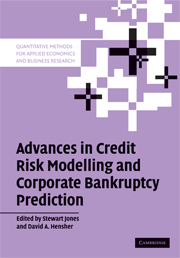Book contents
- Frontmatter
- Contents
- List of figures
- List of tables
- List of contributors
- Introduction
- 1 A statistical model for credit scoring
- 2 Mixed logit and error component models of corporate insolvency and bankruptcy risk
- 3 An evaluation of open- and closed-form distress prediction models: The nested logit and latent class models
- 4 Survival analysis and omitted dividends
- 5 Non-parametric methods for credit risk analysis: Neural networks and recursive partitioning techniques
- 6 Bankruptcy prediction and structural credit risk models
- 7 Default recovery rates and LGD in credit risk modelling and practice: An updated review of the literature and empirical evidence
- 8 Credit derivatives: Current practices and controversies
- 9 Local government distress in Australia: A latent class regression analysis
- 10 A belief-function perspective to credit risk assessments
- Index
- References
5 - Non-parametric methods for credit risk analysis: Neural networks and recursive partitioning techniques
Published online by Cambridge University Press: 11 June 2010
- Frontmatter
- Contents
- List of figures
- List of tables
- List of contributors
- Introduction
- 1 A statistical model for credit scoring
- 2 Mixed logit and error component models of corporate insolvency and bankruptcy risk
- 3 An evaluation of open- and closed-form distress prediction models: The nested logit and latent class models
- 4 Survival analysis and omitted dividends
- 5 Non-parametric methods for credit risk analysis: Neural networks and recursive partitioning techniques
- 6 Bankruptcy prediction and structural credit risk models
- 7 Default recovery rates and LGD in credit risk modelling and practice: An updated review of the literature and empirical evidence
- 8 Credit derivatives: Current practices and controversies
- 9 Local government distress in Australia: A latent class regression analysis
- 10 A belief-function perspective to credit risk assessments
- Index
- References
Summary
Introduction
In all credit analysis problems, a common factor is uncertainty about the continuity of the business being analysed. The importance of business continuity in credit analysis is reflected in the focus, by both academics and practitioners, on constructing models that seek to predict business continuity outcomes (failure or distress). There are two types of modelling exercise that can be useful to decision makers. The first are models that generate the probability of default, an important input to expected loss calculations. The second are classification models, which are used in credit-granting decisions. In this chapter we will look at two non-parametric approaches, neural networks for the generation of default probabilities and classification and recursive partitioning for classification. Each method and its implementation will be presented along with a numeric example.
There is an extensive literature that documents problems in empirical default prediction see Zmijewski (1984), Lennox (1999) or Grice and Dugan (2001). One of the earliest issues was the distributional assumptions that underlie parametric methods, particularly in relation to multiple disriminant analysis (MDA) models. There have been a number of attempts to overcome the problem, either by selecting a parametric method with fewer distributional assumptions or by moving to a non-parametric method. The logistic regression approach of Ohlson (1980) and the general hazard function formulation of Shumway (2001) are examples of the first approach.
- Type
- Chapter
- Information
- Publisher: Cambridge University PressPrint publication year: 2008
References
- 1
- Cited by

